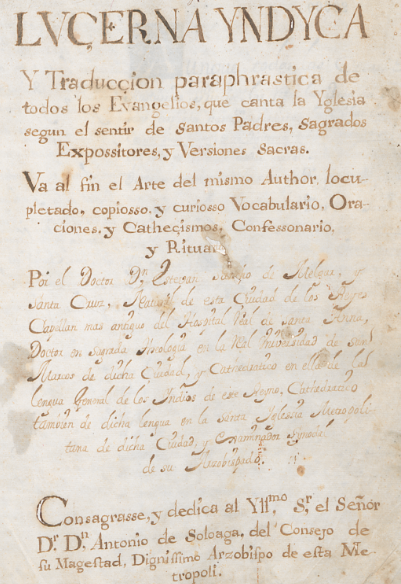
Libraries
Libraries
Lucerna yndyca y traducçion paraphrastica de todos los Evangelios, que canta la Yglesia
In the middle of the XX century, Paul Rivet and Georges de Créqui-Montfort gave the reference of an important Peruvian manuscript for the teaching of Quechua, guarded in the National Archive of Colombia. Today we know that it is guarded in the Biblioteca Nacional de Colombia and that, moreover, is available in digital archive thanks to the World Digital Library. It is the Luçerna Yndyca or Lucerna indica of the sanmarquino professor Esteban Sancho de Melgar known for his Arte de la lengua general del ynga llamada qquechhua. This extensive volume of nearly 500 pages is titled:
LVÇERNA YNDYCA // Y Traducçion paraphrastica de / todos los Evangelios, que canta la Yglesia / segun el sentir de Santos Padres, Sagrados / Expossitores y Versiones Sacras.// Va al fin el Arte del mismo Author locu-/pletado, copiosso y curiosso Vocabulario. Ora-/ciones, y Cathecismos, Confessionario, / y Ritual//
To date, we only know the study that has been elaborated by Gerard Taylor, who read it more than a decade ago from a defective reproduction. Today confirms its correct approximation to the volume, after reviewing the digital support available in the World Digital Library, WDL. The manuscript, because it brings material contained in his Art of 1691, could date from the end of the seventeenth century to the period between 1714 and 1722 (as does the WDL), which corresponds to the archbishopric of Antonio de Soloaga, who dedicates the manuscript to him. However, in the dedication De Melgar asks the archbishop (who was ordained officially in 1715) to deliver the manuscript to Doña María Luisa Gabriela de Saboya, the first wife of Philip V. Since she dies in February 1714, it can be assumed That this manuscript was delivered in January of that year or shortly before the arrival in Perú of the news of his death.
Likewise, in the Dedication, the author reveals the intention of his project: to offer better teaching tools to priests to take the word of Christ to the most remote places of the Viceroyalty of Perú, where the Spanish had not consolidated. The prologue to his specific readers, the priests, shows the special care that De Melgar seeks, on the one hand, an orderly knowledge of the Quechua lexicon for preaching and, on the other hand, very useful philological tools for the correct translation and biblical exegesis of The gospels. Hence the title alludes to the Gospel of John 5:35 where Jesus designates the Baptist as lucerna ardens et lucens, that is, as a burning lamp that illuminates.
The document is highly revealing with regard to the literate culture, both of professors sanmarquinos and of a part of the clergy that maintained serious intentions for the evangelization of the Andean populations. Both the title that equates the priests in America with the mission of the Baptist, and the vast references to classical and Christian Latin authors show the zeal with which De Melgar tried evangelization.
Next, we present, from the transcriptions of Taylor, the parts of the manuscript:
• Dedicatoria y justificación del trabajo (f2r- f6v)
• Prologo a los s(eño)res Curas (f7r- f10v)
• Indice de los Euangelios que contiene esta obra: el primero nu-/mero es el orden de cada Euang(eli)o el segundo es la pagina (f43r-f44r)

